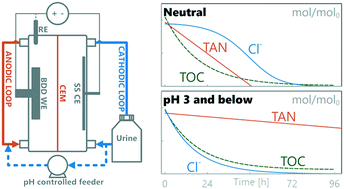Electrochemical system for selective oxidation of organics over ammonia in urine†
Abstract
Source-separated urine can enable efficient nutrient recycling, but the removal of the organic fraction that is required to ensure a safe nutrient product typically also removes the nitrogen in urine (present as total ammonium nitrogen, TAN). In this study, a reagent-free pH control method was used with a two-chamber electrochemical cell with a boron doped diamond (BDD) anode to oxidize synthetic and real urine at different anodic pH values. Without pH adjustment (pH 8.4), all TAN in urine was oxidized in synthetic urine, but at pH ≤3, 79% ± 5% of TAN was retained. Simultaneously, ≥90% of organic content was removed at all pH values with a pH-independent rate. Two different TAN oxidation regimes with corresponding zero-order (i.e. current limited) TAN oxidation rates of −0.02 h−1 and −0.002 h−1 were identified, separated by a chloride to TAN concentration ratio of approximately 0.2 M/M. The higher TAN oxidation rate is linked to a breakpoint chlorination-type oxidation pathway, whereas the lower rate is linked to a direct oxidation pathway on the BDD surface. In addition to TAN, potassium and phosphorus were conserved at 101% ± 6% and 89% ± 4%, respectively. The proposed technology allows for the selective oxidation of the organic fraction in urine while retaining a high proportion of all other key nutrients for potential reuse as a fertilizer.

- This article is part of the themed collection: Recent Open Access Articles


 Please wait while we load your content...
Please wait while we load your content...